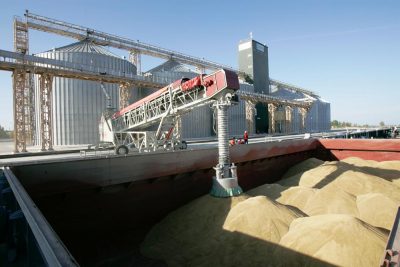China has bought at least 8 million tons of US soybeans this year, according to people familiar with the matter, putting the world’s top importer on track to meet a…
Trump, Trade and Agriculture
China Trade Issues
Back in January of 2016, Maggie Haberman reported at The New York Times Online that, “Donald J. Trump said he would favor a 45 percent tariff on Chinese exports to the United States, proposing the idea during a wide-ranging meeting with members of the editorial board of The New York Times.”
The Times article stated that, “Mr. Trump added that he’s ‘a free trader,’ but that ‘it’s got to be reasonably fair.’
“‘I would do a tax. and the tax, let me tell you what the tax should be … the tax should be 45 percent,’ Mr. Trump said.”

On December 1st, Associated Press writers Paul Wiseman and Joe McDonald reported that, “American consumers and businesses would pay — literally — if President-elect Donald Trump followed through on his campaign pledge to slap big taxes on imports from China and Mexico.
“Trump said during the campaign that he’d impose tariffs of 35 percent on Mexican imports and 45 percent on Chinese imports to protect American jobs from unfair foreign competition.”
More specifically to the agricultural sector, the AP writers explained that, “Farmers in Mississippi, Missouri, Tennessee and Arkansas would suffer if China targeted American soybeans in retaliation for any Trump tariffs, according to the Peterson Institute for International Economics. It said rural Sharkey County, Mississippi, could lose up to 40 percent of its jobs.”
Wiseman and McDonald noted that, “But [Trump’s] team has argued that fears of a destructive trade war are overblown. Trump advisers [Wilbur Ross, an investment banker who is Trump’s choice for Commerce secretary] and Peter Navarro, an economist at the University of California, Irvine, wrote in September that the ‘fear-mongering fails to understand the negotiating power of the U.S.'”
“Navarro and Ross disputed the Peterson report that predicted big potential losses for U.S. soybean farmers;” the AP article said, adding that:
“‘We are world’s largest producer, and they are the world’s largest consumer,’ they wrote of China. ‘If China cuts off American farmers, Chinese people will go hungry.'”

The AP article also added this perspective: “In 2009, the Obama administration imposed tariffs on tires from China, charging that a surge in Chinese imports was hurting American tire makers. Beijing fired back by imposing a tax of up to 105 percent on U.S. chicken feet — a throwaway item in the United States that’s considered a delicacy in China.
“Gary Hufbauer and Sean Lowry of the Peterson Institute found that the tire tariffs probably saved 1,200 jobs in the tire industry. But consumers paid more than $900,000 in higher prices for every job saved.”
Meanwhile, in the broader context of rural America, Peter S. Goodman, Neil Gough, Sui-Lee and Jack Ewing reported on the front page of The New York Times on December 3rd, that, “But many existing American manufacturing jobs depend heavily on access to a broad array of goods drawn from a global supply chain — fabrics, chemicals, electronics and other parts. Many of them come from China.”
The Times article added that, “In short, Mr. Trump’s signature trade promise, one ostensibly aimed at protecting American jobs, may well deliver the reverse: It risks making successful American manufacturers more vulnerable by raising their costs. It would unleash havoc on the global supply chain, prompting some multinationals to leave the United States and shift manufacturing to countries where they can be assured of buying components at the lowest prices.”
Cuba Trade Issues
In his E-newsletter from December 3rd, House Ag Committee member Rick Crawford (R., Ark.) stated that, “While Americans may not be ready for complete repeal of the embargo [with Cuba], if the United States wants to prevent nations like China from dominating Cuba’s future, then we do need to consider ways to increase our influence now, for both national security and economic reasons.

“Reconciling the significant economic opportunity normalization creates with the many legitimate grievances against Cuba’s current government makes finding the right balance a challenge. We suggest an incremental approach beginning with one business sector that can tread the line between the status quo supporters and the private sector’s desire to gain a foothold.”
The newsletter noted that, “Agriculture supports more than 17 million jobs in the United States. Easing trade restrictions could increase American agricultural exports, provide the Cuban people with our quality food, and support rural jobs across our country. Largely elected by a groundswell of rural support, President-elect Donald Trump should be able to entertain a Cuba trade policy that creates opportunity for rural businesses.”
Rep. Crawford added that, “After Fidel’s death, President-elect Donald Trump said, ‘our administration will do all it can to ensure the Cuban people can finally begin their journey toward prosperity and liberty.’ Expanded agricultural trade is the first logical step on that journey that both builds up the Cuban people and respects the sensibilities of embargo supporters.”
Rep. Crawford recently tweeted about his perspective on agricultural trade with Cuba
Why the United States Must Change Stance on Cuba Trade https://t.co/MkiqSxpzx9 via @YouTube
— Rep Rick Crawford (@RepRickCrawford) December 1, 2016
Additional Resources- China Agricultural Trade
For more information on agricultural trade with China, see this recent report from USDA’s Economic Research Service, “China’s Growing Demand for Agricultural Imports;” as well as this farmdoc daily update by Carl Zulauf, “Soybeans, China, and the Rest of the World: Changing of the Guard?“





